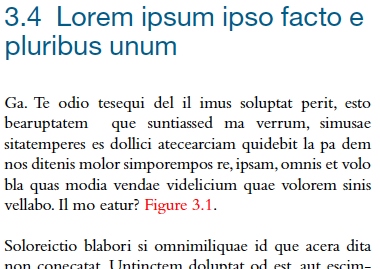Making Some Text Obvious… Temporarily
This is an old trick, but I was reminded of it recently when Aaron Andrade (Design Manager at Inís Communication) wrote to me to explain how he uses it, and I realized that some InDesign users may not know it. The set up is this: Sometimes you want text to be really obvious on the page while you’re working on a document, but then blend back in before printing. Aaron’s example is a great one: Figure references that you need to stand out clearly for checking (and re-checking):

The fact that the x-ref in the image above is red is obvious, even when zoomed out to fit the spread in the window. It catches your eye, reminding you that you’d better zoom in and check it out — after editing, is the figure still near the x-ref? is the number still correct? You get the idea.
But of course you don’t want that text to be red when it goes to press. The solution? As Aaron writes: “To help with this, I temporarily color the references red with an assigned character style (which I call ?LOCATION MARKER?) using the following GREP code in the Body paragraph style:”

Of course, grep styles only works in CS4 and later. In earlier versions, you could manage this by applying the character styles to the text manually, but that’s not as much fun.
Then, when you’re done: “After all layout is basically finalized, simply set the ?LOCATION MARKER? character style to any color (Command-click or Ctrl-click on the red swatch when editing the character style). This reverts the red to the base body font color.” Or, if you were really sure you were finished with editing, you could remove the grep styles from the paragraph style definition.




I use the same method to test GREP codes (if it doesn’t work, nothing or the wrong text will change color).
Rather than removing the GREP styles or changing the applied style’s color, I prefer setting the “Apply Style” option to none so I can turn them on/off at will and keep a record of the GREP codes I used in the document.
@Roland, that makes good sense. In fact as long as the GREP styles are turned on (even with a crippled character style) I bet there’s some slow-down going on…
I do this with footnotes in long documents where I have two or more columns. Doing footnotes spanning columns is very manual process. So you have to keep making sure the footnote numbers are on the same page as the footnote itself, so the footnote number in the text has a Character Style called Superscript.
I often add thick underline in a red or blue or yellow or something, so it envelops the whole number.
This makes the number stand out on the page and I can easily find those superscripted numbers on the page and reference them to the footnote text.
In a recent episode of Dirty Words Design, I show how you can combine this technique with Live Preflight to automatically let you know if all instances of placeholder text have been dealt with:
https://dirtywords.tv/2010/episode_008/